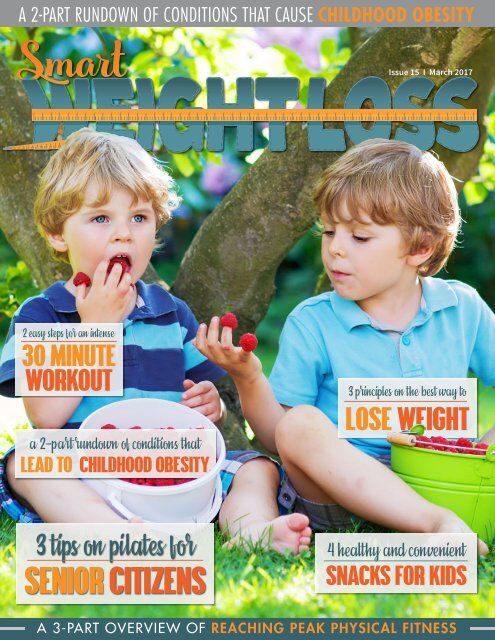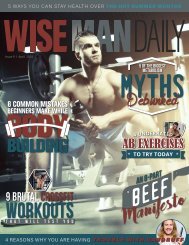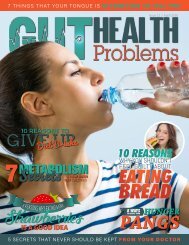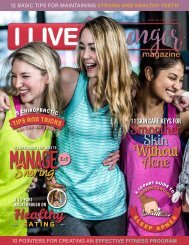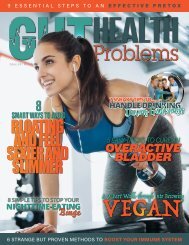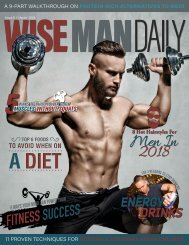Smart Weight Loss - March 2017
With the March 2017 issue of Smart Weight Loss Tips Mag, we'll debunk common myths about weight loss and dieting, show you how to exercise and beat aging, share fast workouts, and more. Once you discover the benefits of healthy, wholesome living, you'll never want to go back to that fad diet again. If you want to learn how to shed fat and start feeling good both in the mind and body, you've come to the right place.
With the March 2017 issue of Smart Weight Loss Tips Mag, we'll debunk common myths about weight loss and dieting, show you how to exercise and beat aging, share fast workouts, and more. Once you discover the benefits of healthy, wholesome living, you'll never want to go back to that fad diet again. If you want to learn how to shed fat and start feeling good both in the mind and body, you've come to the right place.
You also want an ePaper? Increase the reach of your titles
YUMPU automatically turns print PDFs into web optimized ePapers that Google loves.
A 2-PART RUNDOWN OF CONDITIONS THAT CAUSE CHILDHOOD OBESITY<br />
Issue 15 I <strong>March</strong> <strong>2017</strong><br />
2 easy steps for an intense<br />
30 MINUTE<br />
WORKOUT<br />
a 2-p art rundown of conditions that<br />
LEAD TO CHILDHOOD OBESITY<br />
3 p rinciples on the best way to<br />
LOSE WEIGHT<br />
3 tips on pilates for<br />
SENIOR CITIZENS<br />
4 healthy and convenient<br />
SNACKS FOR KIDS<br />
<strong>March</strong> <strong>2017</strong> I<br />
A 3-PART OVERVIEW OF REACHING PEAK PHYSICAL FITNESS1
2<br />
| <strong>March</strong> <strong>2017</strong>
<strong>March</strong> <strong>2017</strong> I<br />
3
Contents<br />
07<br />
11<br />
15<br />
19<br />
23<br />
27<br />
Issue 15 • <strong>March</strong> <strong>2017</strong><br />
4 COMMONLY ACCEPTED<br />
MYTHS ABOUT<br />
METABOLISM<br />
3 TIPS ON PILATES FOR<br />
SENIOR CITIZENS<br />
2 EASY STEPS FOR AN<br />
INTENSE 30 MINUTE<br />
WORKOUT<br />
A 2-PART RUNDOWN<br />
OF CONDITIONS THAT<br />
CAUSE CHILDHOOD<br />
OBESITY<br />
3 PRINCIPLES ON THE<br />
BEST WAY TO LOSE<br />
WEIGHT<br />
4 HEALTHY AND<br />
CONVENIENT SNACKS<br />
FOR KIDS
Contents<br />
A 3-PART OVERVIEW<br />
OF REACHING PEAK<br />
PHYSICAL FITNESS<br />
4 FREQUENTLY ASKED<br />
QUESTIONS ABOUT<br />
EXERCISE AND ANTI-AGING<br />
2 QUICK TIPS FOR TEACHING<br />
KIDS ABOUT FRUITS AND<br />
VEGETABLES<br />
A 3-PART GUIDE TO<br />
EXERCISING WHILE<br />
INJURED<br />
2 REASONS TO START YOUR NEW<br />
FITNESS PLAN TODAY<br />
3 KEY POINTS ON<br />
PREGNANCY AND<br />
AFFECTING YOUR CHILD’S<br />
WEIGHT<br />
31<br />
35<br />
39<br />
43<br />
47<br />
51
Issue 15 I <strong>March</strong> <strong>2017</strong><br />
Editor<br />
Ralph Dozier<br />
Writer<br />
Marianne Williams<br />
Head of Creatives<br />
Nyvia Ross<br />
Graphic Designer<br />
Michael Juanson<br />
Digital Property Managers<br />
Maharlika Matutinao<br />
Layla Anaya<br />
Digital Property Assistants<br />
Krystine Sitjar<br />
Warren Nietes<br />
Online Presence:<br />
Facebook<br />
Google+<br />
Twitter<br />
Tumblr<br />
Pinterest<br />
For advertising concerns<br />
please contact KJ Ross at<br />
kjross@authoritativecontentllc.com<br />
<strong>Smart</strong> <strong>Weight</strong> <strong>Loss</strong> Magazine content<br />
cannot be copied or reproduced in any<br />
form without the written permission<br />
of the publishers. <strong>Smart</strong> <strong>Weight</strong> <strong>Loss</strong><br />
Magazine editors and publishers shall<br />
not be held liable for any unsolicited<br />
materials. All prices and specifications<br />
published in this magazine are subject<br />
to change by manufacturers, agency<br />
and retailers.<br />
6<br />
Welcome to <strong>Smart</strong> <strong>Weight</strong> <strong>Loss</strong> Tips Mag! You’ve made it to a great source of knowledge for your<br />
weight loss and wellness needs. Our team has put together useful guides, tips, and strategies to help<br />
you shed unwanted pounds and transform your life for the better. That all starts today!<br />
In America, it’s no longer news that obesity is an epidemic. Time and time again, statistics are thrown<br />
around showing the correlations between obesity and diseases, as well as other tangential conditions.<br />
In response to this problem that has swept the nation, businesses developed fad diets, poor<br />
quality weight loss pills, and empty promises to trick you into spending money on methods that are<br />
not only inefficient, but may also cause new problems for your health. Unfortunately, that was more<br />
than 15 years ago: today, it’s almost the norm.<br />
At <strong>Smart</strong> <strong>Weight</strong> <strong>Loss</strong> Tips Mag, we’re cognizant of the fact that there is a proper way to lose weight.<br />
You can’t just stop eating, go workout excessively and expect to drop pounds without<br />
creating a whole other set of pitfalls for yourself along the way. If you want<br />
to learn how to shed fat and start feeling good both in the mind and body,<br />
you’ve come to the right place. We’ll debunk common myths about weight<br />
loss and dieting, show you how to exercise and beat aging, share fast<br />
workouts, and more. Once you discover the benefits of healthy, wholesome<br />
living, you’ll never want to go back to that fad diet again.<br />
| <strong>March</strong> <strong>2017</strong><br />
Thanks for reading, and be sure to check out our website!<br />
Regards,<br />
Ralph Dozier<br />
RALPH DOZIER<br />
Editor<br />
<strong>Smart</strong> <strong>Weight</strong> <strong>Loss</strong> Magazine<br />
EDITOR’S NOTE
4 Commonly Accepted<br />
MYTHS ABOUT METABOLISM<br />
by<br />
Ralph Dozier<br />
Follow Us:<br />
These are just 4 of the more popular myths that have perpetuated themselves<br />
over the years. We debunk these and explain what metabolism is really about.<br />
There are<br />
probably as<br />
many myths<br />
about your<br />
metabolism as<br />
there are truths. Some of<br />
the erroneous information<br />
has been around so long<br />
and so widely promoted<br />
that many believe it to<br />
be true. Here are 4 myths<br />
commonly accepted as<br />
truth about metabolism.<br />
Never skip breakfast.<br />
Hot peppers burn more<br />
calories. Caffeine boosts<br />
your metabolism. And<br />
lastly, a pound of muscle<br />
burns 100 calories per day.<br />
1<br />
NEVER SKIP<br />
BREAKFAST<br />
The advice here has always<br />
been to eat breakfast<br />
within an hour after arising<br />
to get your metabolism<br />
revved up from your night<br />
of fasting. The truth is it is<br />
not as important that you<br />
eat as it is what you eat.<br />
<strong>March</strong> <strong>2017</strong> I<br />
7
Make sure your breakfast consists of fiber, lean protein and other nutrients. The cold<br />
hard fact is if you have to choose between a doughnut and nothing, choose nothing. You<br />
don’t need the saturated fat and sugar found in most baked goods. The spike in calories<br />
burned by your metabolism from eating a doughnut isn’t enough to offset the additional<br />
calories ingested.<br />
Pilates can be a great program for the senior citizen. It just requires some modification to a standard<br />
program. Read on to find out more.<br />
<br />
CLICK HERE TO LEARN MORE<br />
2<br />
HOT PEPPERS BURN MORE CALORIES<br />
While it is true that hot peppers burn<br />
calories, a presentation from a recent study<br />
from Experimental Biology suggests mild<br />
peppers have the same calorie potential<br />
without the mouth-singeing agony.<br />
Mild peppers contain the compound<br />
dihydrocapsiate (DCT) while hot peppers<br />
have capsaicin in them. The study found<br />
the group eating mild peppers had about<br />
the same metabolic boost as the group<br />
eating hot peppers and about twice of the<br />
placebo group. Mild peppers include bell,<br />
banana, rellenos and pimentos. Use them<br />
in stir-frys and salads.<br />
8<br />
| <strong>March</strong> <strong>2017</strong>
3<br />
CAFFEINE BOOSTS YOUR METABOLISM<br />
This is mostly true also, but it is highly dependent on the source of your caffeine.<br />
Drinking black coffee and tea provides a small caffeine boost, but if you get caffeine<br />
from energy drinks, you are better off not getting any boost at all. Energy drinks are<br />
loaded with sugar – up to 1/4 cup per drink in some cases. When all that sugar hits<br />
your bloodstream, abundant amounts of insulin are released and what your body can’t<br />
use at that time is stored as fat - belly fat. One of the most dangerous kinds of fat.<br />
If you want to burn more calories, drink more water. Increasing your water consumption<br />
can burn an additional 17,400 calories per year, or about 5 pounds.<br />
4<br />
A POUND OF MUSCLE BURNS 100 CALORIES PER DAY<br />
This myth has been greatly over-exaggerated. Actually while at rest, muscle<br />
burns about 6 calories per pound of muscle per hour. However that is still three<br />
times the amount that fat burns in the same amount of time - at just 2 calories per<br />
pound. So it still pays to lose body fat and gain muscle through exercising – it is<br />
just that the number of calories burned won’t be as great as reported in the media.<br />
These are just 4 of the more popular myths that have perpetuated themselves over the<br />
years. To increase your metabolic rate, it still comes down to eating healthy foods in the<br />
correct portions consistently at the same times, along with cardio and strength training<br />
exercise.<br />
<strong>March</strong> <strong>2017</strong> I<br />
9
10<br />
| <strong>March</strong> <strong>2017</strong>
3 Tips On Pilates For<br />
SENIOR CITIZENS<br />
by<br />
Marianne Williams<br />
Follow Us:<br />
Pilates can be a great program for the senior citizen. It just requires some<br />
modification to a standard program. Read on to find out more.<br />
When thinking about Pilates,<br />
most people think of it as a<br />
way to build core strength to<br />
support the spine. What many<br />
do not know is that it is a good<br />
method of exercising to increase joint<br />
flexibility and range of motion, improve<br />
balance, increase muscle tone, stamina<br />
and well being, along with increasing<br />
muscle strength – all issues in senior<br />
adults.<br />
1<br />
MOBILITY, BALANCE, AND<br />
STRENGTH<br />
Because Pilates is a low impact noncardio<br />
form of exercise, almost<br />
anyone can do it. Many studios report<br />
having clients well in their 80s. The<br />
inventor of the program, Joseph Pilates<br />
practiced his method well into his 80s!<br />
A studio with good instructors can tailor<br />
a Pilates program to improve mobility,<br />
<strong>March</strong> <strong>2017</strong> I<br />
11
alance and strengthen physical weaknesses. Falls, due to one losing their balance,<br />
is one of the most reported injuries of seniors. A common result is breaking a hip of<br />
which many at that age never fully recover. Practicing Pilates can help prevent falls and<br />
reduce the risk of suffering a debilitating injury as a result.<br />
These are just 4 of the more popular myths that have perpetuated themselves over the years. We<br />
debunk these and explain what metabolism is really about.<br />
<br />
2<br />
CLICK HERE TO READ MORE.<br />
CHECK WITH YOUR HEALTH-CARE PROVIDER<br />
While it is never too late to start a Pilates program, be sure and check<br />
with your health-care provider before starting any exercise program. What<br />
you don’t want to do is to get into a program that is too challenging for you<br />
and end up getting hurt. Even with a program that is right for you, be sure<br />
to listen to your body and participate at a level you can comfortably do.<br />
12<br />
| <strong>March</strong> <strong>2017</strong>
If you have osteoporosis, be sure your instructor knows. Pilates involves a lot of<br />
twisting, bending forward and performing certain exercises involving bearing weight –<br />
all things people with osteoporosis are not suppose to do. It isn’t a problem if your<br />
instructor knows as s/he can tailor a program just to you.<br />
3<br />
TYPES OF PILATES CLASSES<br />
There are two types of Pilates<br />
classes. One type uses just a mat while<br />
the other one incorporates specialized<br />
equipment that increase the resistance<br />
of the performed exercises. While either<br />
type is good for seniors, the mat classes<br />
can be performed at home. That can be<br />
a huge advantage if you have a lot of ice<br />
and snow where you live and don’t want<br />
to risk a fall by going out. Many senior<br />
citizen centers offer both types of Pilates<br />
that are tailored to the older person.<br />
As you can see, Pilates can be a great<br />
program for the senior citizen. It just<br />
requires some modification to a standard<br />
program and the participant doing what<br />
they are comfortable with and within their<br />
limitations.<br />
<strong>March</strong> <strong>2017</strong> I<br />
13
14<br />
| <strong>March</strong> <strong>2017</strong>
2 Easy Steps For An Intense<br />
30 MINUTE WORKOUT<br />
by<br />
Ralph Dozier<br />
Follow Us:<br />
Getting into shape doesn’t mean having to spend an hour in the gym each day.<br />
Here’s how to get an effective workout in just 30 minutes, three times a week.<br />
The good news<br />
is that if you<br />
are pushed<br />
for time, you<br />
absolutely<br />
CAN fit an<br />
effective workout into<br />
a 30-minute time slot.<br />
And if you are<br />
exercising for weight loss,<br />
researchers from the<br />
University of Copenhagen<br />
found that a 30-minute<br />
workout is just as effective<br />
as one that takes an<br />
hour. So what does a fullbody<br />
workout look like?<br />
Start by jogging one mile<br />
to your gym. If it is close<br />
enough to your house<br />
great; if not, park a mile<br />
away and jog in. Once<br />
there, take 5 minutes to<br />
warm up the muscles<br />
you are going to work in<br />
your workout with some<br />
dynamic stretching. You<br />
don’t have to worry about<br />
stretching your leg muscles<br />
as they are already warmed<br />
up from your jog.<br />
<strong>March</strong> <strong>2017</strong> I<br />
15
What is your peak physical fitness goal? Depending on your goal, it could take months to years to reach it.<br />
Here’s what you need to know.<br />
<br />
CLICK HERE TO LEARN MORE<br />
1<br />
THE FIRST TWELVE MINUTES<br />
Now your 30-minute clock starts.<br />
Next take 12 minutes and work the<br />
following parts of the body with these<br />
exercises. For your chest, triceps and<br />
shoulders, do bench presses, military<br />
presses, and overhead extensions.<br />
For back, biceps and shoulders, we<br />
suggest pull downs, bent over rows,<br />
and bicep curls. For your calves, quads,<br />
hamstrings and glutes, try lunges,<br />
squats, and leg curls or extensions.<br />
The number of repetitions performed<br />
of each exercise depends on your<br />
goal of working out. To build strength<br />
and muscle size, do 4 to 6 reps with<br />
heavier weights; for general fitness,<br />
12 to 15 reps with moderate weights;<br />
for fat burning and endurance, 20<br />
to 25 reps with lighter weights.<br />
Lunges and squats can be done either<br />
with or without weights; however, the<br />
weights will work your muscles more. If<br />
you are just starting working out, select a<br />
weight that will be just heavy enough to<br />
make your last repetition difficult. Once<br />
that last repetition of the exercise is no<br />
longer difficult, increase the weight and<br />
drop back on the number of repetitions.<br />
This strategy will ensure that you keep<br />
progressing with your fitness level.<br />
16<br />
| <strong>March</strong> <strong>2017</strong>
2<br />
THE NEXT TWELVE MINUTES<br />
For the next 12 minutes, repeat<br />
the routine again. Finish out your<br />
30-minute clock by working your core<br />
muscles with crunches and oblique<br />
crunches, leg raises, jackknives and<br />
static planks. Finally jog back to your car.<br />
This routine is so effective because<br />
it works every major muscle group<br />
twice in quick succession. Do this<br />
routine 3 times per week (with a day<br />
in between each workout for recovery)<br />
and get into the best shape of your life.<br />
Getting into shape does not mean having<br />
to spend an hour in the gym each day<br />
working out. As the above routine shows,<br />
you can get an effective workout in just 30<br />
minutes, three times a week.<br />
<strong>March</strong> <strong>2017</strong> I<br />
17
18<br />
| <strong>March</strong> <strong>2017</strong>
A 2-Part Rundown Of Conditions That Cause<br />
CHILDHOOD OBESITY<br />
by<br />
Marianne Williams<br />
Follow Us:<br />
If your child is obese, could a medical condition be causing it? This information<br />
may be what gives your child a chance at enjoying a healthy body weight.<br />
Could some type of medical<br />
condition or illness be<br />
causing your child to be<br />
obese? Before we can answer<br />
that question, the actual<br />
definition of childhood obesity needs to<br />
be understood. The Mayo Clinic and other<br />
respected health organizations define<br />
childhood obesity as: “A serious medical<br />
condition that occurs when a child is well<br />
above the normal weight for his or her age<br />
and height.”<br />
1<br />
DETERMINING IF YOUR CHILD IS<br />
OBESE<br />
The best way to discover whether<br />
your child weighs more or less than<br />
average is to consult a “BMI percentile<br />
calculator for kids”. Simply type that<br />
term into Google or some other search<br />
engine. You will find several free online<br />
resources which explain your child’s<br />
BMI percentile. (ex. A score of 90 or 95<br />
means your child is more overweight<br />
than 90% or 95% of all children his age<br />
<strong>March</strong> <strong>2017</strong> I<br />
19
and height, which qualifies for obesity).<br />
If you find that your child is obese, could<br />
a medical condition be causing it? A poor<br />
diet and lack of exercise can definitely<br />
cause obesity in children. Your lifestyle<br />
when you are pregnant also directly<br />
relates to whether your child will be<br />
overweight or not. And while uncommon,<br />
some medical conditions and ailments can<br />
actually increase your child’s chances of<br />
becoming obese.<br />
2<br />
MEDICAL CONDITIONS THAT CAUSE<br />
OBESITY IN CHILDREN<br />
These are usually linked to genetics and<br />
heredity. For instance, hypothyroidism<br />
is a condition where the thyroid gland<br />
is underactive. This means that it does<br />
not correctly control metabolism, which<br />
can lead to overweight and obesity. A<br />
simple thyroid checkup can identify<br />
this problem. Prader-Willi syndrome<br />
is another genetically linked disorder.<br />
This can cause an uncontrollable<br />
20<br />
| <strong>March</strong> <strong>2017</strong>
By exercising smartly, you can keep other areas of your body in shape while an injured area is healing.<br />
Here’s what you need to know.<br />
<br />
CLICK HERE TO READ MORE.<br />
urge to eat that is created when the<br />
brain incorrectly understands when<br />
your child’s body is hungry or full.<br />
Cushing’s syndrome is a medical<br />
condition which is sometimes caused<br />
by medications prescribed for asthma<br />
sufferers. This disorder means that your<br />
body receives too much exposure to the<br />
hormone cortisol. This can also come<br />
from a biological or genetic problem<br />
which causes your adrenal glands to<br />
overproduce cortisol. The side effect<br />
is weight gain and possibly obesity.<br />
Aside from those few medical conditions,<br />
there are not too many more illnesses<br />
or diseases which cause childhood<br />
obesity that a balanced diet, plenty of<br />
water and frequent exercise cannot<br />
positively impact. Children in low income<br />
neighborhoods and those frequently<br />
suffering from stress and anxiety also run<br />
a higher risk of obesity than average. Keep<br />
your child mentally and physically active,<br />
provide a healthy, loving and stress-free<br />
environment, and you give him a great<br />
opportunity at enjoying a healthy body<br />
weight.<br />
<strong>March</strong> <strong>2017</strong> I<br />
21
22<br />
| <strong>March</strong> <strong>2017</strong>
3 Principles On The Best Way To<br />
LOSE WEIGHT<br />
by<br />
Ralph Dozier<br />
Follow Us:<br />
Which approach is best? The key to weight loss is in understanding your body,<br />
as you will soon understand after reading this article.<br />
When it comes to<br />
weight loss, there<br />
are generally<br />
three schools<br />
of thought. The<br />
first is extreme dieting. This<br />
involves strictly following<br />
the instructions of the<br />
latest dieting trend to make<br />
headlines. The measures are<br />
extreme, and the results are<br />
generally short lived. The<br />
second is balanced<br />
dieting—controlling your<br />
calorie intake against the<br />
amount of calories you burn<br />
during the day. Creating a<br />
calorie deficit is said to result<br />
in weight loss.<br />
The third is metabolism<br />
boosting. Your metabolism<br />
is the process by which your<br />
body turns food into energy.<br />
A slow metabolism leads to<br />
your body storing food as fat,<br />
while a fast metabolism burns<br />
through food more quickly. So<br />
which approach is best?<br />
<strong>March</strong> <strong>2017</strong> I<br />
23
It is extremely important to understand what lifestyle activities negatively affect your child’s birth weight, as<br />
well as their weight as a child.<br />
CLICK HERE TO LEARN MORE<br />
1<br />
EXTREME DIETING VS BALANCED<br />
DIETING<br />
First up, let’s look at extreme dieting.<br />
It’s nonsense. You might see short term<br />
results, but it is generally completely<br />
unsustainable. Put it out of your mind.<br />
That was easy! OK, so what about balanced<br />
dieting vs. working on your metabolism?<br />
This one isn’t so easy. Unfortunately,<br />
proponents of both are often quick to<br />
disparage the benefits of the other. The<br />
reality is that a balanced diet and boosting<br />
your metabolism should really go hand<br />
in hand. They are intrinsically linked, and<br />
keeping both in mind is the best way to<br />
approach weight loss.<br />
2<br />
METABOLISM BOOSTING<br />
There are many ways to boost your<br />
metabolism, but the most important is<br />
to make sure you are eating enough of<br />
the right foods. Severely reducing your<br />
calorie intake actually slows down your<br />
metabolism, making weight loss even<br />
more difficult. In order to lose weight,<br />
you need to maintain your calorie intake.<br />
This involves being aware of just how<br />
many calories you are taking in, and<br />
how you are getting them. By substituting<br />
fatty, high calorie foods for greater<br />
portions of healthy, low calorie foods,<br />
you will speed up your metabolism and<br />
lose weight more quickly.<br />
24<br />
| <strong>March</strong> <strong>2017</strong>
3<br />
AEROBIC EXERCISE<br />
Another closely linked aspect of<br />
dieting and metabolism is exercise.<br />
Aerobic exercise burns calories, but<br />
by increasing your heart rate you can<br />
encourage your metabolism to work<br />
faster, greatly increasing the benefits.<br />
A good way to increase your heart rate<br />
is to introduce high intensity periods<br />
to your exercise. For joggers, this could<br />
be breaking out into a sprint for 30<br />
seconds every couple of minutes. For<br />
walkers, this could be increasing to a<br />
jog for 30 seconds every few minutes.<br />
The truth is that there is no definitive<br />
answer to the question of dieting vs<br />
metabolism. A balanced diet (and not a<br />
severe calorie cutting diet) will naturally<br />
improve your metabolism. Similarly, foods<br />
and activities to boost your metabolism<br />
will result in a more balanced diet.<br />
The key is in understanding your body.<br />
Understand the foods it needs and what<br />
positively impacts your metabolism. Only<br />
by keeping both in mind can you see<br />
sustained, permanent weight loss.<br />
<strong>March</strong> <strong>2017</strong> I<br />
25
26<br />
| <strong>March</strong> <strong>2017</strong>
4 Healthy And Convenient<br />
SNACKS FOR KIDS<br />
by<br />
Ralph Dozier<br />
Follow Us:<br />
Making your own snacks<br />
for your kids is not only<br />
cheaper, but you control<br />
what goes into them.<br />
Here are some easy but<br />
nutritious snacks that<br />
fill the bill.<br />
Besides eating three meals<br />
per day, kids also need three<br />
healthy snacks. But what<br />
constitutes healthy? Generally,<br />
you will want to stick to the<br />
basic food groups of whole grain, fruits<br />
and vegetables, and dairy. Here are some<br />
easy to prepare, but nutritious snacks that<br />
fill the bill.<br />
1<br />
WHOLE GRAIN CEREAL CLUSTERS<br />
Start with 3 cups of whole grain<br />
cereal, 1/2 cup chopped dried strawberries<br />
and 1 1/2 cups of white chocolate chips.<br />
Put the cereal and strawberries on a bowl.<br />
Melt the chocolate and drizzle it over the<br />
bowl mixture. Mix up the melted chocolate<br />
and bowl mixture. Spoon into mini muffin<br />
cups, and refrigerate until firm.<br />
2<br />
CHEESE AND FRUIT KEBABS<br />
When cut into fun shapes, these<br />
are a real hit with your kids. Take 4<br />
cantaloupe or honeydew slices (or 2<br />
slices of each), 4 fresh blackberries,<br />
4 whole fresh strawberries, 2 ounces<br />
of reduced fat cheddar or Monterey<br />
Jack cheese and a few stick pretzels.<br />
Using a 1 to 1 1/2 inch cookie cutter, cut<br />
<strong>March</strong> <strong>2017</strong> I<br />
27
With exercise and healthy eating, you’ll look years younger than you really are, have more energy and<br />
in general feel better.<br />
CLICK HERE TO READ MORE.<br />
out shapes from the melon slices and<br />
cheese. Thread the fruit and cheese onto<br />
the stick pretzels and chill.<br />
3<br />
FRUIT SMOOTHIE<br />
While you can buy fruit<br />
smoothies, most are loaded with<br />
unneeded sugar. You can make healthy<br />
ones at home (and for less money).<br />
Start with an 8 ounce container of<br />
nonfat vanilla yogurt, 1 banana, 1 cup of<br />
strawberries or peaches and 1/2 cup of<br />
orange juice. Put all of the ingredients into<br />
a blender and whip. Serve in glasses.<br />
28<br />
| <strong>March</strong> <strong>2017</strong>
4<br />
SNACK MIX<br />
This snack only takes 15 minutes to make from start to finish.<br />
Ingredients needed are 6 cups of popped popcorn, non-stick cooking<br />
spray, 2 cups of potato sticks, 3 tablespoons of grated parmesan cheese,<br />
1 1/2 cups of peanuts or almonds, and 1 cup of mixed dried fruit.<br />
Start by popping popcorn either in the microwave or air popper. Lightly coat with<br />
the cooking spray and toss to coat the popcorn evenly. Sprinkle on the parmesan<br />
cheese and toss again. Finish by stirring in the potato sticks, nuts and dried fruit.<br />
All of these recipes are healthy snacks that take almost no time to prepare. And all<br />
recipes are kid-proven to be something they will eat. Making your own snacks for your<br />
kids is not only cheaper, but you control what goes into them. Many pre-made snacks<br />
are loaded with sugar, salt and unhealthy fats. At least when you make it yourself, you<br />
can be sure what they eat between meals is healthy and nutritious.<br />
<strong>March</strong> <strong>2017</strong> I<br />
29
30<br />
| <strong>March</strong> <strong>2017</strong>
A 3-Part Overview Of<br />
REACHING PEAK<br />
PHYSICAL FITNESS<br />
by<br />
Ralph Dozier<br />
Follow Us:<br />
What is your peak physical fitness goal? Depending on your goal, it could take<br />
months to years to reach it. Here’s what you need to know.<br />
Before you can<br />
reach your peak<br />
physical fitness,<br />
you have to<br />
define what<br />
peak is for you; it won’t<br />
be the same for everyone.<br />
For you, it may be reaching<br />
a professional level in a<br />
sport, such as getting on<br />
the Olympic swim team,<br />
or finishing a marathon,<br />
or winning a powerlifting<br />
competition. Or it could<br />
be something as simple as<br />
losing weight and being<br />
able to exercise for an hour<br />
at a time without getting<br />
exhausted. What is your<br />
peak physical fitness goal?<br />
1<br />
YOUR GOAL OVER<br />
THE COURSE OF TIME<br />
Once you have defined it, you<br />
have to be willing to devote<br />
the time, focus, sacrifice<br />
and commitment in order to<br />
achieve it. In many cases we<br />
<strong>March</strong> <strong>2017</strong> I<br />
31
are talking years of effort. How you train and how often, along with when, what and how<br />
much you eat, how much you sleep, and how often you socialize all impact on working<br />
toward your goal. Everything you do should be focused on working toward your goal.<br />
And keep in mind that the older you get, the harder it will be to achieve your peak<br />
physical fitness goal. From a physiological standpoint, we have the best opportunity to<br />
reach our peak when we are in our late 20’s to early 30’s.<br />
Getting into shape doesn’t mean having to spend an hour in the gym each day. Here’s how to get an effective<br />
workout in just 30 minutes, three times a week.<br />
<br />
CLICK HERE TO LEARN MORE<br />
2<br />
DON’T WAIT TOO LONG<br />
After that, our bodies begin to<br />
change. We start to lose muscle mass after<br />
age 50. Our metabolism begins to wane by<br />
10 percent at retirement age. We normally<br />
flexibility to the tune of 3 to 4 inches on the<br />
sit and reach test. And we begin to lose bone<br />
density after age 65; all factors that affect<br />
fitness performance in your later years.<br />
The point - don’t wait too long to work<br />
toward your fitness peak. As each year<br />
ticks by, it will get harder and harder to<br />
maintain your current fitness level let<br />
alone reaching a loftier one.<br />
32<br />
| <strong>March</strong> <strong>2017</strong>
3<br />
GET A CHECK UP<br />
If you have been sedentary for a while, first get a check-up to ensure you are<br />
healthy enough to begin training. Once cleared, then begin by focusing on activities<br />
that will increase your mobility and strength. While you won’t reach your goal and get<br />
“fit” doing these activities, you will gain confidence in your ability to exercise, get less<br />
sore as you go along and you will start to see results in as little as a couple of weeks.<br />
Work up to exercising 150 minutes<br />
per week (30 minutes per day five<br />
days per week) of moderate-intensity<br />
cardiovascular exercise as recommended<br />
by the U.S. Department of Health and<br />
Human Services. In addition, two days per<br />
week add in strength training exercises<br />
that work the major muscle groups. Give<br />
your body time to rest and repair itself by<br />
taking one day per week off from training.<br />
Once you can easily accomplish this<br />
training intensity, you have achieved a<br />
good physical fitness base and can start<br />
working up toward your peak physical<br />
fitness goal. You will most likely need a<br />
fitness coach or personal trainer at some<br />
point to further define the training you<br />
need to reach your peak. Keep in mind<br />
that depending on your goal, it could take<br />
months to years to reach it.<br />
<strong>March</strong> <strong>2017</strong> I<br />
33
34<br />
| <strong>March</strong> <strong>2017</strong>
4 Frequently Asked Questions About<br />
EXERCISE AND ANTI-AGING<br />
by<br />
Ralph Dozier<br />
Follow Us:<br />
With exercise and healthy eating, you’ll look years younger than you really are,<br />
have more energy and in general feel better.<br />
It’s been proven many times<br />
over that exercising can help<br />
you look and feel younger, but<br />
exactly what kind of exercises<br />
should you be doing? Broken<br />
down into two broad categories, it should<br />
be a mix of cardio and strength training.<br />
Below, we explain what you should know<br />
about these, as well as eating right.<br />
1<br />
WHAT IS CARDIO?<br />
Doing anything that raises your<br />
heart rate qualifies as cardio training. So<br />
whether you ride a bike, walk, jog, play<br />
tennis or swim laps, all of it gets your blood<br />
flowing faster. This gets more oxygen to<br />
your cells and more carbon dioxide out.<br />
In a study done at McMaster University in<br />
<strong>March</strong> <strong>2017</strong> I<br />
35
Ontario Canada, researchers had one group of mice run in a wheel while the other group<br />
did nothing for exercise. What they found in the group that exercised is that every aspect<br />
of their health and appearance improved, verses the control group that did nothing.<br />
But that was only part of the story; they also found that the control group’s fur started<br />
graying and balding. In the group that exercised, their fur did not gray, nor did they<br />
experience balding.<br />
Making your own snacks for your kids is not only cheaper, but you control what goes into them. Here<br />
are some easy but nutritious snacks that fill the bill.<br />
<br />
2<br />
CLICK HERE TO READ MORE.<br />
WHAT DOES CARDIO DO FOR US?<br />
In another study - this time on humans - a doctor took skin samples from inactive<br />
people over 65 years old. Half of the group was put through a cardio exercise routine for three<br />
months. The doctor then took another skin sample from each and did a comparison study.<br />
What he found was the group that exercised had improved skin; both their inner and<br />
outer layers had significantly improved. So much so that he concluded their skin was of<br />
the same age as a 40-year old.<br />
36<br />
| <strong>March</strong> <strong>2017</strong>
3<br />
WHAT IS STRENGTH TRAINING?<br />
As we age, we lose bone density,<br />
muscle mass and tone. By using light<br />
weights or resistance bands, but doing<br />
many repetitions, you can slow the loss<br />
of bone, keep muscle tone and maintain<br />
mass. Heck, you can even build muscle<br />
mass after age 65 with the right program!<br />
The second aspect of looking and feeling<br />
younger is eating the right foods. Stay<br />
away from fast and processed foods, and<br />
diet soda.<br />
4<br />
HOW IMPORTANT IS EATING RIGHT?<br />
Instead, focus on eating lean meats<br />
and fish, whole grains, nuts, and fresh<br />
fruits and vegetables. Each of these<br />
foods adds something special to your<br />
diet, so to have a complete nutrient<br />
plan you need some from each group.<br />
The other half of eating right is portion<br />
control. As we get older, our metabolism<br />
starts to slow down, so we don’t need as<br />
much food as we once did to maintain our<br />
current weight. Read labels to see how<br />
much a portion really is as packaging can<br />
lead you into eating more than one serving.<br />
Doing cardio, strength training and<br />
eating right is as close to the fountain<br />
of youth as anything we have. Exercising<br />
on a consistent basis not only increases<br />
endurance and stamina, but it improves<br />
muscle tone and skin. With exercise and<br />
healthy eating, you’ll look years younger<br />
than you really are, have more energy and<br />
in general feel better and have a more<br />
youthful outlook on life.<br />
<strong>March</strong> <strong>2017</strong> I<br />
37
38<br />
| <strong>March</strong> <strong>2017</strong>
2 Quick Tips For<br />
TEACHING KIDS ABOUT<br />
FRUITS AND VEGETABLES<br />
by<br />
Marianne Williams<br />
Follow Us:<br />
You should start the fruits and vegetables education early for your kids.<br />
Here’s how to introduce your child to them as part of hands-on learning.<br />
Your child is plugged<br />
into the electronic<br />
world in a big way.<br />
While this can<br />
definitely be a<br />
negative, leading to a sedentary<br />
lifestyle, it can also help teach your<br />
child about the benefits of fruits<br />
and vegetables as part of a healthy<br />
lifestyle. You can alternately<br />
go “old-school” and introduce<br />
your child to fruits and veggies<br />
as part of a hands-on learning<br />
process. Both of those methods<br />
are recommended. Here’s why.<br />
Kids love getting outdoors. But<br />
they also enjoy consuming video<br />
and audio on smartphones,<br />
tablets, MP3 players and<br />
computers. So when you employ<br />
both of these methods in an effort<br />
to get your child fired up about<br />
vegetables and fruits, you stand a<br />
better chance of success.<br />
<strong>March</strong> <strong>2017</strong> I<br />
39
1<br />
GET YOUR CHILD OUT INTO A PHYSICAL GARDEN<br />
If you don’t grow your own produce, find someone that does. Local<br />
farmers, community gardening clubs and perhaps even your own neighbors<br />
will usually be happy to give you and your child a hands-on experience and<br />
education about growing fruits and vegetables. The entire seed-to-harvest process<br />
can be shown, touched, smelled and even tasted. Promote encouragement<br />
by telling your children that this is the acceptable way for them to get dirty.<br />
Don’t wait until after the New Year to start your fitness plan. Start now and get ahead of the game. Here’s why<br />
you should get going.<br />
<br />
CLICK HERE TO LEARN MORE<br />
If you do not have access to a fruits and vegetables garden, head to the supermarket.<br />
Schedule a “Supermarket Fun Day” to promote eating plenty of fruits and vegetables.<br />
Make a game of finding 5 different vegetables and fruits in each of the 5 main color<br />
groups. Let your child see, touch and smell the many different types of produce, and tell<br />
them the health benefits of each one. (This exercise will help make you smarter about<br />
why you should be eating veggies and fruits as well.)<br />
40<br />
| <strong>March</strong> <strong>2017</strong>
2<br />
THERE’S AN APP FOR THAT<br />
Nothing can beat real world<br />
examples which involve all 5 senses for<br />
teaching any kind of lesson. But your<br />
child is a technologically-inclined human<br />
being. Why not cater to this inclination?<br />
The list of applications and games<br />
which teach the nutritional benefits<br />
and the growing process of fruits and<br />
vegetables is nearly endless. Here are<br />
a few to consider: FoodChamps.org;<br />
Nicolas’ Garden (actually designed by<br />
an 8 year old); The Prisoner of Carrot<br />
Castle; Fooducate; Food Truth; Awesome<br />
Eats; Eat-And-Move-O-Matic; Max’s Plate;<br />
and Fruits and Vegetables for Kids.<br />
These games and applications are<br />
free and available for most mobile<br />
operating systems. They make learning<br />
about vegetables and fruits a game<br />
that your kids want to play all the time.<br />
Just remember to start young. Children<br />
develop their unique personality between<br />
the ages of 1 and 4. They are absorbing<br />
everything, even when you do not realize<br />
it. So start the fruits and vegetables<br />
education early for a lifetime of healthy<br />
nutrition.<br />
<strong>March</strong> <strong>2017</strong> I<br />
41
42<br />
| <strong>March</strong> <strong>2017</strong>
A 3-Part Guide To<br />
EXERCISING WHILE INJURED<br />
by<br />
Marianne Williams<br />
Follow Us:<br />
By exercising smartly, you can<br />
keep other areas of your body<br />
in shape while an injured area<br />
is healing. Here’s what you<br />
need to know.<br />
First thing, if you get injured,<br />
don’t go it alone. Go see your<br />
doctor and get the injury<br />
evaluated. It might be more<br />
serious than you think. By not<br />
knowing exactly what was injured and how<br />
bad, you risk injuring it all over again if you<br />
start training that injured area too soon.<br />
With some injuries, your doctor will<br />
prescribe physical therapy in order to get<br />
the injury to heal properly. Don’t play mister<br />
tough-guy and blow this off. Go get the<br />
therapy. It really does help you heal faster.<br />
While at the doctor or at physical therapy,<br />
ask what exercises they recommend you<br />
can still do to keep training, but not further<br />
damage the injured area. Depending on<br />
the location of your injury, here are some<br />
they could recommend.<br />
1<br />
LOWER BODY<br />
If your injury happens to be from the<br />
waist down, then you will want to focus on<br />
exercises where you can lay down or sit<br />
and use your upper body. Chest presses,<br />
overhead dumbbell presses, lateral pull<br />
downs and seated rows are all good as<br />
<strong>March</strong> <strong>2017</strong> I<br />
43
If your child is obese, could a medical condition be causing it? This information may be what gives<br />
your child a chance at enjoying a healthy body weight.<br />
<br />
CLICK HERE TO READ MORE.<br />
they take the pressure off of the area<br />
that is injured. For something different,<br />
try seated boxing or working a hand bike.<br />
If you have an ankle sprain you could also<br />
include different plank variations from<br />
the knees as long as it does not aggravate<br />
your injury. Or try doing push-ups; just<br />
cross the injured ankle over the good one<br />
and do normal push-ups.<br />
2<br />
UPPER BODY<br />
With an upper body injury, you<br />
will most likely be limited to lower body<br />
exercises, like leg extensions and lifts,<br />
lunges, squats and step-ups. If your<br />
injury is to your hand or wrist, you can<br />
probably also do some plank variations<br />
and exercises that work your abdominal<br />
core. If the injury is your elbow then<br />
probably not. Depending on where<br />
44<br />
| <strong>March</strong> <strong>2017</strong>
your injury is located, you might be able<br />
to use a stationary bike comfortably.<br />
The injuries in your core are tricky, as your<br />
back and neck are used in most exercises<br />
as well as your shoulders if you do<br />
anything with barbell or dumbbells. Most<br />
likely you’ll want to focus on doing lower<br />
body exercises from a laying position -<br />
something that will support your back.<br />
3<br />
LISTEN TO YOUR BODY<br />
While you may be able to do the above<br />
recommended exercises, don’t overlook<br />
what your body is telling you. If you are<br />
experiencing pain at a level of 5 or 6 (on<br />
a scale of 10), then you most likely should<br />
not do that exercise until you are healed.<br />
Because of the poses and the way<br />
yoga is done, you may benefit from<br />
it as an alternative form of exercise<br />
while injured. The Hatha yoga style is<br />
a slower style of yoga. Explain to the<br />
master why you want to do yoga and<br />
get some recommendation from him.<br />
As you can see, there are options to<br />
keep exercising even while injured. Use<br />
common sense and listen to your body. By<br />
exercising smartly, you can keep the other<br />
areas of your body in shape while the<br />
injured area is healing.<br />
<strong>March</strong> <strong>2017</strong> I<br />
45
46<br />
| <strong>March</strong> <strong>2017</strong>
2 Reasons To Start Your<br />
NEW FITNESS PLAN TODAY<br />
by<br />
Marianne Williams<br />
Follow Us:<br />
Don’t wait until after the New Year to start your fitness plan. Start now and<br />
get ahead of the game. Here’s why you should get going.<br />
Why do we wait<br />
until after the<br />
first of the New<br />
Year to implement<br />
our new fitness<br />
plan? We’ve known for<br />
months that we’re going to<br />
do it. It seems as though we<br />
fear that if we start before<br />
the festive season is over,<br />
we’ll undo all that we gained<br />
during that period of time,<br />
so we’ll start afterwards<br />
and not lose anything.<br />
The problem with that line<br />
of thinking is that we start<br />
behind the curve. What<br />
would happen if we had<br />
started say 2 months before<br />
Thanksgiving? At a one-pound<br />
loss per week, we would have<br />
already lost 8 pounds before<br />
the holidays started. Even<br />
after the holidays you’ll still<br />
weigh less than when you<br />
started.<br />
<strong>March</strong> <strong>2017</strong> I<br />
47
You should start the fruits and vegetables education early for your kids. Here’s how to introduce your child to<br />
them as part of hands-on learning.<br />
CLICK HERE TO LEARN MORE<br />
1<br />
YOUR FITNESS HABIT WILL SET IN<br />
BY THE HOLIDAYS<br />
By starting your New Year’s fitness plan<br />
early, it will already have become a habit<br />
by the time the New Year rolls around.<br />
You’ve probably heard it takes about<br />
21 days to a month for something to<br />
become a habit. Science tells us it takes<br />
longer if the action is more complex and<br />
with multiple variables such is the case<br />
with establishing a new fitness routine.<br />
Oh, and if you are waiting to start your<br />
new fitness routine until the time is right<br />
—it will never be right, so as the popular<br />
American sports and sportswear company<br />
Nike says “Just do it!”. Do it at home or at<br />
a gym? Your new fitness routine doesn’t<br />
have to involve spending a lot of money.<br />
48<br />
| <strong>March</strong> <strong>2017</strong>
2<br />
YOU DON’T NEED TO GET IN A GYM<br />
If you can’t afford a gym<br />
membership, there are literally hundreds<br />
of exercise DVDs that you can buy<br />
and exercise in the comfort of your<br />
home. Some may require small pieces<br />
of equipment like a set of dumbbells<br />
or a stepper, but many will use just<br />
bodyweight and require no equipment.<br />
Or you may find the perfect workout<br />
for you on YouTube and those are free.<br />
However, if you want a gym membership,<br />
go ahead and buy one. Most gyms<br />
offer reduced price memberships to<br />
new customers. Sometimes the act<br />
of “going to the gym” is motivation<br />
enough for people to get their money’s<br />
worth from their membership.<br />
Regardless of how you do it, once your<br />
new fitness plan has become a habit, it<br />
will be as natural as brushing your teeth<br />
or going to work each day. Don’t wait until<br />
after the New Year to start your fitness<br />
plan. Start now and get ahead of the<br />
game.<br />
<strong>March</strong> <strong>2017</strong> I<br />
49
50<br />
| <strong>March</strong> <strong>2017</strong>
3 Key Points On Pregnancy And Affecting<br />
YOUR CHILD’S WEIGHT<br />
by<br />
Marianne Williams<br />
Follow Us:<br />
It is extremely important to understand what lifestyle activities negatively affect<br />
your child’s birth weight, as well as their weight as a child.<br />
Moms-to-be are now more<br />
intelligently informed than<br />
ever before concerning<br />
pregnancy and childbirth. This<br />
means most pregnant women<br />
are aware of how their lifestyle choices<br />
during this important time can affect so<br />
many aspects of their child’s life. A healthy<br />
birth weight has been directly linked to<br />
fewer health problems as a child, teen and<br />
adult. That is why it is extremely important<br />
to understand what lifestyle activities<br />
negatively affect your child’s birth weight,<br />
as well as their weight as a child.<br />
1<br />
YOUR UNBORN CHILD IS EATING<br />
WHAT YOU ARE EATING<br />
If you have ever been pregnant, you know<br />
that sometimes you crave the weirdest<br />
food combinations. That is because your<br />
child is not getting some minerals or<br />
nutrients that it needs, or is depleting<br />
your personal supply. They need to be<br />
replenished, and fast. So your body sends<br />
your brain a signal that says, “Eat ice<br />
cream, anchovies and a cheeseburger.”<br />
Those particular eating habits directly<br />
affect the weight of your child. A research<br />
<strong>March</strong> <strong>2017</strong> I<br />
51
team from Singapore, New Zealand and<br />
the UK proved that, while revealing some<br />
startling information. 317 mothers and<br />
children were monitored for 9 years,<br />
from pregnancy to birth and early<br />
childhood. Pregnant women that ate few<br />
carbohydrates during early pregnancy<br />
were more likely to give birth to children<br />
with a tendency to have a greater<br />
than average body fat for their age.<br />
So it is very important for you as a pregnant<br />
woman to eat a balanced diet, full of<br />
carbohydrates, healthy fats and protein.<br />
Limiting any one of these necessary food<br />
types impacts your child’s weight. A study<br />
from the University of Southampton<br />
reveals a very similar relationship.<br />
Which approach is best? The key to weight loss is in understanding your body, as you will soon understand<br />
after reading this article.<br />
<br />
2<br />
CLICK HERE TO READ MORE.<br />
PREGNANCY DIET, NOT MOM’S WEIGHT, DICTATES CHILDHOOD OBESITY RISK<br />
In the study, it made little difference whether a pregnant woman was fat or<br />
skinny. What dictated a drastically heightened risk for obesity in a child, even 6 or 9<br />
years after birth, was an unbalanced diet. Since smoking and drinking alcohol directly<br />
affect your level of nutrition, they also negatively impact not only the birth weight of<br />
your child, but also his risk of being overweight or obese as both a child and adult.<br />
52<br />
| <strong>March</strong> <strong>2017</strong>
Learning disabilities, heart problems and<br />
birth defects are well known side effects<br />
of a pregnancy where the mother-to-be<br />
smokes and/or drinks alcohol. Smoking can<br />
even lower your possibility of becoming<br />
pregnant in the first place. If you insist on<br />
smoking while you’re pregnant, your child<br />
has an increased risk of being born with a<br />
low to dangerously low birth weight.<br />
3<br />
THE CHOICES MOM MAKES ARE<br />
HIGHLY IMPACTFUL<br />
Smoking during pregnancy also raises<br />
the risk that your child will be obese,<br />
even as an adult. Alcohol abuse, enjoying<br />
more than 3 to 5 drinks a week, can also<br />
lead to a heightened rate of childhood<br />
obesity that continues into adult years.<br />
The choices you make now, while you are<br />
pregnant, affect the chemical processes<br />
going on inside your body. Those<br />
processes are what your unborn child<br />
depends on to stamp its chemical and<br />
physiological makeup. Eat balanced meals,<br />
stop smoking, and keep the drinking to a<br />
minimum or cut it out altogether to give<br />
your child the best chance at a healthy<br />
birth weight, and a decreased chance of<br />
becoming obese as a child and adult.<br />
<strong>March</strong> <strong>2017</strong> I<br />
53
54<br />
| <strong>March</strong> <strong>2017</strong>
<strong>March</strong> <strong>2017</strong> I<br />
55
TUNE IN<br />
FOR OUR<br />
NEXT<br />
ISSUE!<br />
• 3 TIPS ON TV TIME AND YOUR<br />
CHILD’S WEIGHT<br />
• 4 WAYS TO MAKE SURE YOUR KIDS<br />
GET ENOUGH EXERCISE<br />
• 4 REASONS WHY SLEEP IS ESSENTIAL<br />
FOR WEIGHT LOSS<br />
• 2 QUICK TIPS ON EXERCISING WHILE<br />
YOU HAVE A COLD<br />
• A 3-PART GUIDE TO KEEPING FIT IN<br />
THE WINTER<br />
• 6 STRATEGIES FOR HELPING YOUR<br />
PICKY EATER EAT HEALTHY FOOD<br />
• A 3-PART OVERVIEW OF MEAL SIZE<br />
FOR WEIGHT LOSS<br />
Follow Us:<br />
56<br />
The April edition of<br />
<strong>Smart</strong> <strong>Weight</strong> <strong>Loss</strong><br />
will be available this spring.<br />
| <strong>March</strong> <strong>2017</strong>


